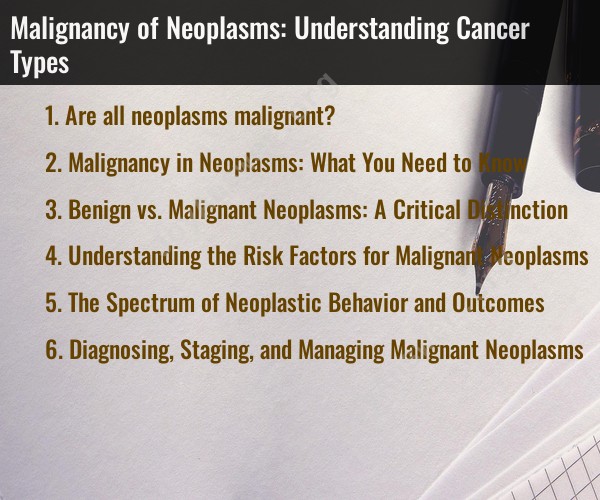Are all neoplasms malignant?
No, not all neoplasms (abnormal growths or tumors) are malignant. Neoplasms can be broadly categorized into two main types: benign and malignant. These terms refer to the behavior and characteristics of the growth. Here's the distinction:
Benign Neoplasms:
- Benign neoplasms are non-cancerous growths.
- They typically grow slowly and tend to remain localized, not invading nearby tissues or spreading to other parts of the body (metastasis).
- Benign neoplasms often have well-defined borders and a regular, uniform appearance under a microscope.
- They usually do not pose a significant threat to health and are often curable with surgical removal.
- Examples of benign neoplasms include moles, fibroids, and some types of cysts.
Malignant Neoplasms (Cancer):
- Malignant neoplasms are cancerous growths.
- They tend to grow rapidly and have the potential to invade nearby tissues and spread to distant parts of the body through the bloodstream or lymphatic system.
- Malignant neoplasms often have irregular borders and an invasive appearance under a microscope.
- They can be life-threatening and require various treatment approaches, including surgery, radiation therapy, chemotherapy, and targeted therapies.
- Examples of malignant neoplasms include lung cancer, breast cancer, and melanoma.
In summary, the key difference between benign and malignant neoplasms is their behavior. Benign neoplasms are non-cancerous, slow-growing, and localized, while malignant neoplasms are cancerous, fast-growing, and have the potential to spread and harm nearby and distant tissues. Diagnosing and distinguishing between these two types of neoplasms is essential for proper treatment and management.
Malignancy in Neoplasms: What You Need to Know
Neoplasms are abnormal growths of tissue. They can be benign (non-cancerous) or malignant (cancerous). Malignant neoplasms are characterized by uncontrolled cell growth and the ability to invade and spread to other parts of the body.
Benign vs. Malignant Neoplasms: A Critical Distinction
Benign neoplasms are typically slow-growing and do not invade or spread to other parts of the body. They may cause problems if they press on nearby organs or tissues, but they are not life-threatening.
Malignant neoplasms, on the other hand, are fast-growing and can invade and spread to other parts of the body through the bloodstream or lymphatic system. This process is called metastasis.
Metastasis is what makes cancer so dangerous. If cancer cells reach other parts of the body, they can form new tumors and damage nearby tissues.
Understanding the Risk Factors for Malignant Neoplasms
There are many risk factors for malignant neoplasms, including:
- Age: The risk of developing cancer increases with age.
- Family history: People with a family history of cancer are at increased risk of developing the disease themselves.
- Tobacco use: Tobacco smoke contains carcinogens, which are substances that can cause cancer.
- Excessive alcohol consumption: Alcohol consumption can increase the risk of developing certain types of cancer, such as liver cancer and esophageal cancer.
- Diet: A diet high in processed meats and red meat and low in fruits and vegetables can increase the risk of developing certain types of cancer.
- Exposure to radiation: Exposure to ultraviolet radiation from the sun or ionizing radiation from medical procedures can increase the risk of developing cancer.
- Certain infections: Some infections, such as the human papillomavirus (HPV) and hepatitis C virus, can increase the risk of developing certain types of cancer.
The Spectrum of Neoplastic Behavior and Outcomes
The behavior and outcomes of malignant neoplasms vary widely depending on the type of cancer, the stage at which it is diagnosed, and the individual's overall health.
Some cancers are very aggressive and can spread quickly, while others are less aggressive and may grow slowly over many years. Some cancers are highly treatable, while others are more difficult to treat.
Even within the same type of cancer, there can be a great deal of variation in behavior and outcome. For example, some people with breast cancer may respond well to treatment and have a good prognosis, while others may not respond well to treatment and may have a poorer prognosis.
Diagnosing, Staging, and Managing Malignant Neoplasms
The first step in managing malignant neoplasms is to diagnose the disease. This typically involves a combination of physical examination, imaging tests, and laboratory tests.
Once cancer is diagnosed, the next step is to stage the disease. Staging is a process of determining how far the cancer has spread. This information is used to guide treatment decisions and to provide a prognosis for the patient.
There are a variety of treatment options for malignant neoplasms, including:
- Surgery: Surgery is often the first-line treatment for cancer. It can be used to remove the tumor or to shrink it before other treatments are given.
- Radiation therapy: Radiation therapy uses high-energy rays to kill cancer cells.
- Chemotherapy: Chemotherapy uses drugs to kill cancer cells throughout the body.
- Targeted therapy: Targeted therapy uses drugs to target specific molecules that are involved in cancer cell growth and survival.
- Immunotherapy: Immunotherapy helps the body's own immune system to fight cancer cells.
The best treatment for malignant neoplasms depends on the type of cancer, the stage of the disease, and the individual's overall health.
Conclusion
Malignant neoplasms, also known as cancer, are serious diseases that can be life-threatening. However, there are many effective treatments available, and the survival rate for many types of cancer has improved significantly in recent years.
If you have any concerns about malignant neoplasms, be sure to talk to your doctor.












